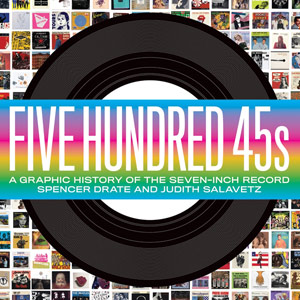
by Spencer Drate and Judith Salavetz
Collins Design
Like many folks above a certain age (if you got your first music via a computer, perhaps you should stop reading here), Spencer Drate and Judith Salavetz were first turned onto music via the once ubiquitous 45. Those 7-inch pieces of vinyl could be found at just about any five-and-dime, drug, grocery or department store and could be had for under a dollar, letting any kid with a hi-fi and an allowance access to the universe of pop music. I myself bought my first 45 at a northeast Ohio regional K-mart equivalent when I was eight years-old. That slab was Pink Floyd’s “Another Brick in the Wall (Part II),” purchased mainly for its rebellious chorus of “Hey! Teachers! Leave them kids alone!”
That first single came in just a plain brown Columbia sleeve, but in Five Hundred 45s: A Graphic History of the Seven-Inch Record, Drate and Salavetz, who have worked as creative directors, designers and authors on a bunch of music- and pop culture–related books—including the previously published 45 RPM: A Visual History of the Seven-Inch Record—take a look at the art of picture-sleeved 45s. Much like its musical component’s two brief sides, a 45’s wrapper is a snapshot visual encapsulation of an artist and/or the song. That small square is a quick jump through the looking glass, a brief opportunity to peer into the realm just beneath the surface of the music. And while the 45’s larger sibling, the album, also presents a similar occasion for graphic representation, the accessibility (and perhaps disposability) of the 45 format somehow seems more easily penetrable.
Like its title implies, Five Hundred 45s presents 500 sleeves (not that I actually counted them), the majority rendered full-size. Drate and Salavetz seem to have focused on the aesthetic value of the sleeves themselves and not so much on whatever musician’s music that was contained within. Still, they cover broad ground, from the pompadoured glossies of Ritchie Valens and Bobby Vinton to the photocopied renderings of the Avengers and the Art Attacks. The book is stunning, to say the least, with themes emerging from one sleeve to the next, as well as shifts in time being marked by technique and form.
Of course, it goes without saying that the 45 sleeve is a dying art. Even more than with LPs (which, in case you haven’t read any of the tens of articles saying so that have been published this past decade, have made a comeback), the single was not made for the digital age. Or at least not the one being covered in this book, as the idea of the single has returned, only as a downloadable package devoid of a visual component. Sure, there are plenty of 7-inches being printed and several labels doing singles clubs, but with slim profit margins, there’s not the same level of artistic talent behind those sleeves.
While the book is worth getting just for the pictures (and it’s okay to admit that), it’s certainly not devoid of text. Drate and Salavetz both offer up personal reflections on their relationship to 45s, while Lenny Kaye takes his own experiences of buying singles on Flatbush Avenue and further discusses the social importance of the form as well as some of its history in his excellent introduction. Similarly, documentary filmmaker and record collector Stuart Goldman relates the tale of his first Elvis 45 and Agit writer Eric Davidson discusses his reasons for spending 15 bucks on a Dwarves 7-inch. These personal recollections are nice intermissions amongst the barrage of imagery and seem the logical textual component to the book’s very loosely organized visuals. Thus, it seems odd to also include John Foster’s essay on the work of graphic artist Jeff Kleinsmith or Bruce Licher’s description of using a letterpress for Savage Republic’s sleeves or even Tom Hazelmyer’s brief history of the 7-inch’s importance in punk rock. Each of these contributions would suggest another tack entirely (one more scholarly, perhaps) and don’t really jibe with the general celebratory feel of the tome. But such minor imperfections aside, Five Hundred 45s succeeds in encapsulating a small portion of this vast array of singular art.
Stephen Slaybaugh
David Cross, Bigger and Blackerer
Rock 'n' Roll High School
Beach House Live Review
I Need That Record!
The Specials Live Review
The Antlers Live Review
Girls and the Wedding Present Live Reviews
The Big Pink and A Place to Bury Strangers Live Review
Jello Biafra and the Guantanamo School of Medicine and Joanna Newsom Live Reviews
SXSW 2010 Recap
Blank Generation
Leatherface, Pere Ubu, and RJD2 Live Reviews
The TAMI Show
The Soundtrack of Our Lives Live Review
